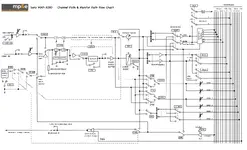A
astokesmusic
Member
Hello. I'm learning about recording consoles, specifically a classic in-line recording console at the moment. Is anyone familiar with the flow charts used to track the signal-flow for these analog recording consoles? I have to create a flow chart for one with these I/O controls and specifications:
Keeping in mind that:
1. Under normal conditions, the mic preamp feeds the small fader path, which can be assigned to the stereo bus; the multitrack feeds the large fader path, which can be assigned to both the multitrack busses and the stereo bus. The large fader path feeds the direct out, post fader.
2. The "24" switch gives the small fader path access to the multitrack busses, instead of the large fader path. Both paths can still be assigned to the stereo bus.
3. The tape switch feeds the multi-track signal to the small fader path (in addition to the large fader path).
4. The mic switch feeds the mic preamp output to the large fader path (in addition to the small fader path).
5. The EQ switch puts the EQ into the small fader path, instead of the large fader path.
6. The -6 dB pad affects the return from multitrack only, but will affect both the small and large fader paths when the tape switch is engaged.
7. The VU meter can be switched to indicate any one of the following: small channel input level, large channel input level, or direct output level. This last selection reflects any changes made through the large channel fader.
8. The mute switches cut the post-fader aux sends, but not the pre-fader aux sends.
9. The mute switch in each path will cut the direct out and/or multitrack bus signal when either of these are being sourced from that path.
10. The "DIR" switch gives the small fader path access to the direct output post-fader, instead of the large fader path.
The attached image is an example I am supposed to create my flow chart similar to, of course, mine can be a little less detailed.
This is all very new to me, so I'm basically just asking for some help as to where certain things should go and meet with other things (in terms of the symbols and stuff). If anyone understands this sort of thing quite well and could help me make sense of it, I also have Discord and I could communicate there easier and give more examples of what I'm going for.
Thank you!
- mic preamp/trim
- small fader
- large fader
- large channel input trim
- small channel stereo pan pot
- large channel stereo pan pot
- VU meter
- large channel aux send pot
- small channel aux send pot
- tape switch
- mic switch
- small channel mute
- large channel mute
- -6 dB pad
- EQ switch
- direct "DIR" switch
- "24" switch
- pre/post aux send switches
Keeping in mind that:
1. Under normal conditions, the mic preamp feeds the small fader path, which can be assigned to the stereo bus; the multitrack feeds the large fader path, which can be assigned to both the multitrack busses and the stereo bus. The large fader path feeds the direct out, post fader.
2. The "24" switch gives the small fader path access to the multitrack busses, instead of the large fader path. Both paths can still be assigned to the stereo bus.
3. The tape switch feeds the multi-track signal to the small fader path (in addition to the large fader path).
4. The mic switch feeds the mic preamp output to the large fader path (in addition to the small fader path).
5. The EQ switch puts the EQ into the small fader path, instead of the large fader path.
6. The -6 dB pad affects the return from multitrack only, but will affect both the small and large fader paths when the tape switch is engaged.
7. The VU meter can be switched to indicate any one of the following: small channel input level, large channel input level, or direct output level. This last selection reflects any changes made through the large channel fader.
8. The mute switches cut the post-fader aux sends, but not the pre-fader aux sends.
9. The mute switch in each path will cut the direct out and/or multitrack bus signal when either of these are being sourced from that path.
10. The "DIR" switch gives the small fader path access to the direct output post-fader, instead of the large fader path.
The attached image is an example I am supposed to create my flow chart similar to, of course, mine can be a little less detailed.
This is all very new to me, so I'm basically just asking for some help as to where certain things should go and meet with other things (in terms of the symbols and stuff). If anyone understands this sort of thing quite well and could help me make sense of it, I also have Discord and I could communicate there easier and give more examples of what I'm going for.
Thank you!

